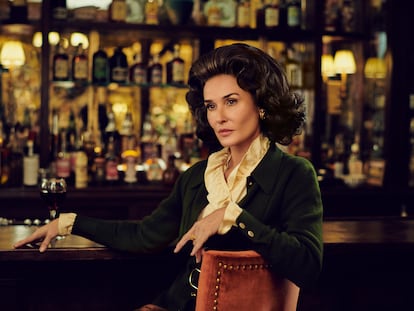A prince, a magnate, a Churchill and a mysterious murder victim: These were the powerful men behind Capote’s ‘swans’
The new season of ‘Feud’ explores Truman Capote’s betrayal at the hands of his privileged circle of Manhattan friends in the 1970s. Their husbands were millionaires, frequently unfaithful… and sometimes, victims themselves

In 2017, Ryan Murphy debuted Feud, a series with anthological aspirations that looks to recreate and explains the golden age of U.S. culture’s juiciest rivalries. In its first season, the rancor between Bette Davis and Joan Crawford took center stage, a great excuse for exposing Hollywood’s cruelty, ageism and the machismo that was replicated by the divas of yesteryear. After an attempt at a second season that would have recreated the bitter end of the marriage between Charles of England and Diana of Wales, the show was canceled in 2018. Murphy bounced back with a $300 million contact with Netflix, which already had a series exploring the British royal family’s trials and travails in The Crown. Five years passed before Feud would confirm its second season, and seven before it actually debuted.
Feud: Capote vs the Swans, was announced in 2022 and came out last week. It centers on the stories of friendship and betrayal lived out by writer Truman Capote and his swans, high society stars who he entertained and was entertained by until one ill-fated day in November 1975, when Capote published an Esquire magazine story entitled La Côte Basque, 1965, an excerpt from what was to be his new novel, Answered Prayers. In the text, he revealed intimacies — even some criminal acts — that his friends had confessed to him and, although the protagonists appeared under pseudonym as in any good roman à clef, neither New York society nor the affected women themselves were unaware of the protagonists’ true identities.
The tale’s publication was the end of that circle of friends, and also the beginning of the end for Capote, who was ostracized by the elite world he loved so much. The writer’s alcoholism worsened dramatically and he never managed to finished Answered Prayers, which can be read today as an unfinished work composed of only the three chapters that originally saw the light of day. In Feud, this florid saga is brought to life by the usual, spectacular Murphy cast full of his factory of stars, highlighted by female powerhouses. Naomi Watts, Demi Moore, Diane Lane, Calista Flockhart, Molly Ringwald and Chloë Sevigny play the ladies, varying from idle to hateful, that so fascinated Capote with their lifestyle and refinement. Alongside them, their husbands, figures who in the series remain in the background, but are fascinating not only for being men of enormous power and influence, but also for being the architects and even victims of the women who initially inspired the author of In Cold Blood, and eventually destroyed him.
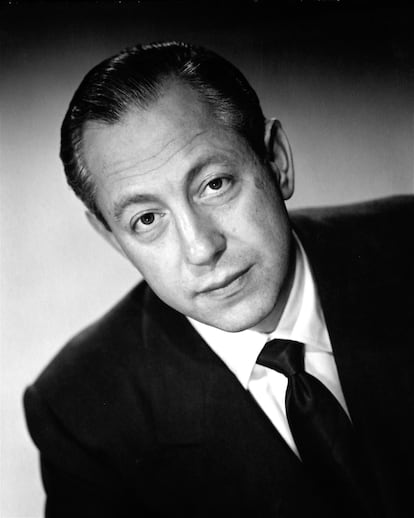
William S. Paley, the lord and master of television
Husband of: Babe Paley, played by Naomi Watts.
Treat Williams, who died in a motorcycle accident in 2023, plays tycoon William S. Paley, founder of CBS. Paley’s story could not be more American: the son of Ukrainian Jews who became rich in tobacco, he realized when advertising his products on a small radio station that the real opportunities lay in media. He began buying stations to form a complex conglomerate that soon included television. In a fabulous amalgam of sentiment and business, Paley married Dorothy Hart Hearst, ex-wife of one of the sons of William Randolph Hearts, king of newspapers and the inspiration for Citizen Kane. Paley’s numerous infidelities eventually put an end to the relationship. His 1947 marriage to Babe Cushing, Vogue fashion editor, kept up an appearance of respectability and happiness until the end, which came with her death in 1978.
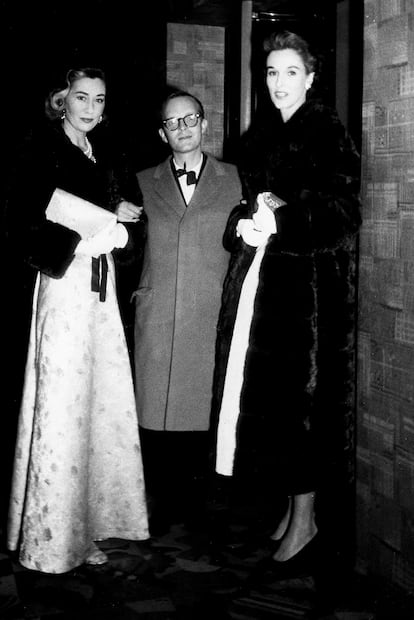
Paley would later boast that he and Babe never spent more than five nights apart during their marriage. In reality, they had quite a few skeletons in the closet, and Capote gave a good account of them in his article, recounting how Paley cheated on Babe with “the governor’s wife,” supposedly Happy Rockefeller, spouse of Nelson Rockefeller. Other unphotogenic details include the fact that Paley spent years paying a $200-a-month pension to his paramour, disgraced actress Louise Brooks (who is the subject of her own film, The Chaperone), on the condition that she would not reveal anything about their affair (which she eventually did anyway, in her memoir Lulu in Hollywood). After being widowed, Paley had a relationship with the model and actress Barbara Allen, who was 50 years younger and alternated between him and Bryan Ferry.
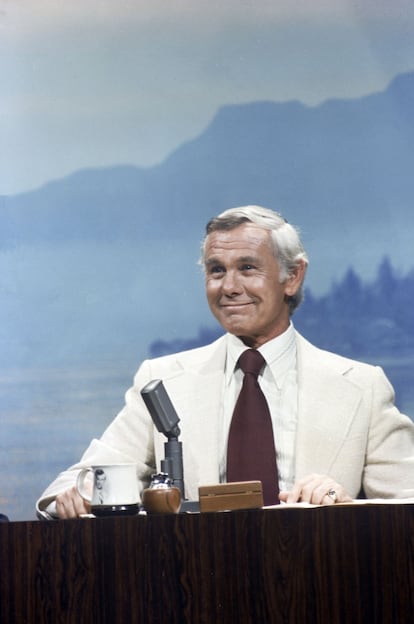
Johnny Carson, the beloved and unfaithful host
Husband of: Joanne Carson, played by Molly Ringwald.
“Here’s Johnny!” Living legend of television, the host of The Tonight Show, pioneer of late-night television (with Ed Sullivan’s blessing), he was a U.S. institution the size of Mt. Rushmore. Carson’s romantic life rose to similar heights: he tallied four wives and several lovers, among which were the comedian Joan Rivers, starlet Mamie Van Doren and actress Morgan Fairchild. Others, like Sally Field, refused to date him, referring to him as “an octopus.” PanAm flight attendant Joanne Copeland and Carson married in 1963, after he got a divorce from his first wife. Their partnership ended in 1972, when Carson confirmed his suspicions that Joanne was having an affair with football player Frank Gifford, whom she’d see in a secret Manhattan flat that was full of photos of the athlete.
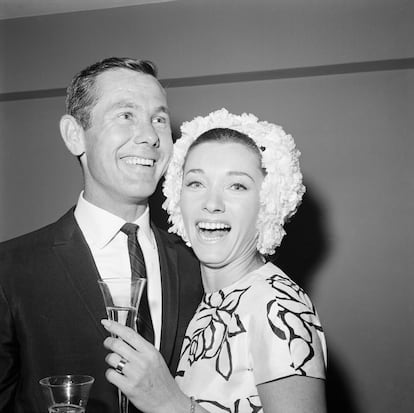
Their divorce came soon after, and that same year, in 1972, the jilted Carson (although he, too, had been unfaithful to his wife) married another Joanne, Joanna Holland. It was a short-lived marriage. His fourth and final wife was Alexis Maas. Joanne Carson received substantial alimony payments until her ex-husband’s death in 2005. In 1974, Joanne would attempt to write a book about the show business she had come to know intimately. It was never completed, though Capote did help to heavily edit the text. She was one of the few who did not completely withdraw her support of him after the publication of La Côte Basque. When the writer died in 1984, he was in Joanne’s home on Sunset Boulevard.

Stanislaw Albrecht Radziwill, the prince
Husband of: Lee Radziwill, Calista Flockhart in the series.
What’s a high-society woman who is expected to make certain decisions in life to do when her sister marries a charismatic politician who will become president of the United States? Up the ante with something that, in the United States, holds foriegn caché: blue blood. According to Capote, that is what Lee Bouvier, sister of Jacqueline, wife of John F. Kennedy, did when she married Polish prince “Stash” Radziwill. She would deny jealousy as a motivating factor for the rest of her life, but it is true that on paper, Stash seemed as much a match as her husband as John was for Jackie.
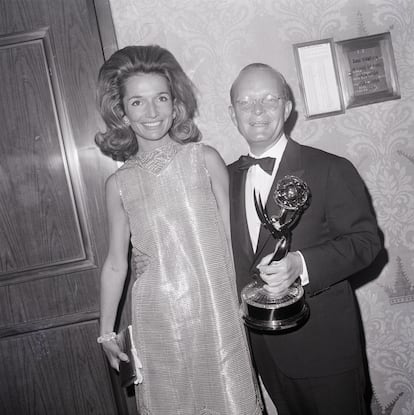
A sophisticated mix of diplomat, entrepreneur and businessman, Stash had already been divorced twice, and resided in two English mansions to which was soon added a Manhattan apartment that was to Lee’s liking. Both Lee and Stash were married to other people at the time they met — she to Michael Temple Canfield — and it should be noted that the fact that their first son, Anthony, was born four and a half months after their wedding may have been a motivating factor in their union.
They were not a happy couple. Soon, Aristotle Onassis entered the picture and became the object of Lee’s affections — but as it happened, he would end up marrying Jackie. She had affairs when her marriage was on the rocks with Mark Shand, brother of the current Queen Camilla of England, and the photographer Peter Beard. The divorce came in 1974. Just two years later, Stash died in London at the age of 62, cloaked in the mystery and obscurity with which he spent his life, despite being the husband of one of the most watched women in the world.
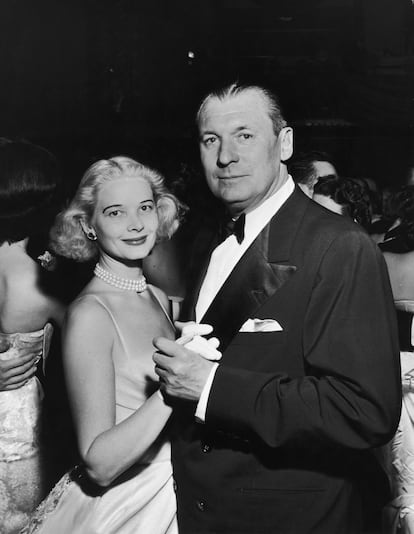
Winston Frederick Churchill Guest (yes, of those Churchills)
Husband of: C.Z. Guest, played by Chloë Sevigny.
If with such a grand accumulation of names — yes, he was a cousin of Winston Churchill — a person still was unable to guess Winston Frederick Churchill Guest’s pedigree, perhaps it would help to know that he was also a polo champion. A millionaire who was well-connected by birth, Guest led a harmonious and uneventful existence. After divorcing in 1944 from his first wife, Helena Woolworth McCann, who would not have been out of place in an Edith Wharton novel, he married Lucy Douglas Cochrane in 1947. She was better known as C.Z. (read: Sissy), in Hemingway’s Cuban mansion. Considered one of the best-dressed women of her day, C.Z. was such a prodigy of elegance that she managed to emerge unscathed from Capote’s indiscretions.
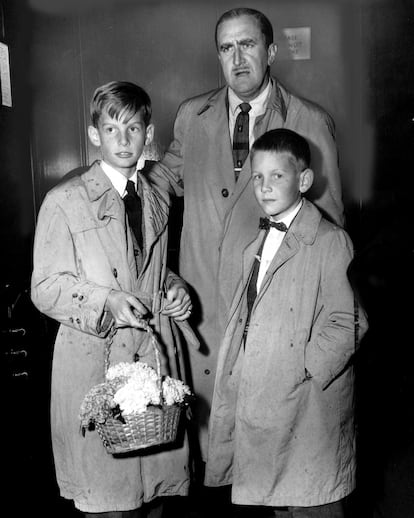
Jimmy Woodward, the murder victim
Husband of: Ann Woodward, Demi Moore in Feud.
Here, the gossip gets dark. Ann Woodward shot and killed her husband, millionaire Jimmy Woodward — played in the series by Hudson Oz — according to her, accidentally, mistaking him for an intruder. Rumors soon circulated that it was no accident, that the marriage had been in trouble and Jimmy was planning to divorce his wife, whose background and education was of a lower social class than his own. Despite being exonerated by the justice system, Ann could never beat this persistent slander, which would be put into print by Capote’s story in Esquire, where she was somewhat lazily renamed Ann Hopkins. Unable to cope with the ostracism, Ann committed suicide in 1975, three days before the issue of the magazine came out. The whole sordid affair would be picked up by Dominick Dunne in his stupendous novel The Two Mrs. Grenvilles, in which Capote himself appears in camouflage, adding yet another literary layer to this game of reality and fiction.
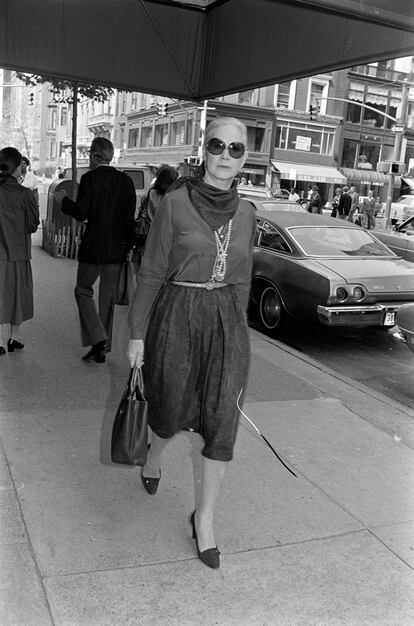
Sir Kenneth Keith, the English patient
Husband of: Slim Keith, played by Diane Lane.
Baron Keith of Castleacre was the third husband of Nancy Gross, nicknamed Slim for her height and svelte figure, but by no means the most interesting. The life of this actress, socialite and aristocrat was marked by encounters and romances with tempestuous personalities. The first of these, actor William Powell, fell in love with her when she was only 16 years old. Director Howard Hawks abandoned his wife, Norma Shearer’s sister, to marry Slim, and modeled Lauren Bacall’s character in To Have and Have Not after her bubbly, brash personality.

After Slim’s split with Hawks, she went to Cuba to stay at Hemingway’s house, where she fell in love with agent Leland Hayward, who was married to Margaret Sullivan, ex-wife of Henry Fonda and William Wyler. Slim and Hayward had a happy marriage, until he left her for socialite Pamela Churchill. That’s when Kenneth Keith entered the scene. Slim nearly died from boredom during a quiet life with him in England, and they divorced in 1972.
Sign up for our weekly newsletter to get more English-language news coverage from EL PAÍS USA Edition
Tu suscripción se está usando en otro dispositivo
¿Quieres añadir otro usuario a tu suscripción?
Si continúas leyendo en este dispositivo, no se podrá leer en el otro.
FlechaTu suscripción se está usando en otro dispositivo y solo puedes acceder a EL PAÍS desde un dispositivo a la vez.
Si quieres compartir tu cuenta, cambia tu suscripción a la modalidad Premium, así podrás añadir otro usuario. Cada uno accederá con su propia cuenta de email, lo que os permitirá personalizar vuestra experiencia en EL PAÍS.
¿Tienes una suscripción de empresa? Accede aquí para contratar más cuentas.
En el caso de no saber quién está usando tu cuenta, te recomendamos cambiar tu contraseña aquí.
Si decides continuar compartiendo tu cuenta, este mensaje se mostrará en tu dispositivo y en el de la otra persona que está usando tu cuenta de forma indefinida, afectando a tu experiencia de lectura. Puedes consultar aquí los términos y condiciones de la suscripción digital.
More information
Archived In
Últimas noticias
Most viewed
- Sinaloa Cartel war is taking its toll on Los Chapitos
- Oona Chaplin: ‘I told James Cameron that I was living in a treehouse and starting a permaculture project with a friend’
- Reinhard Genzel, Nobel laureate in physics: ‘One-minute videos will never give you the truth’
- Why the price of coffee has skyrocketed: from Brazilian plantations to specialty coffee houses
- Silver prices are going crazy: This is what’s fueling the rally
